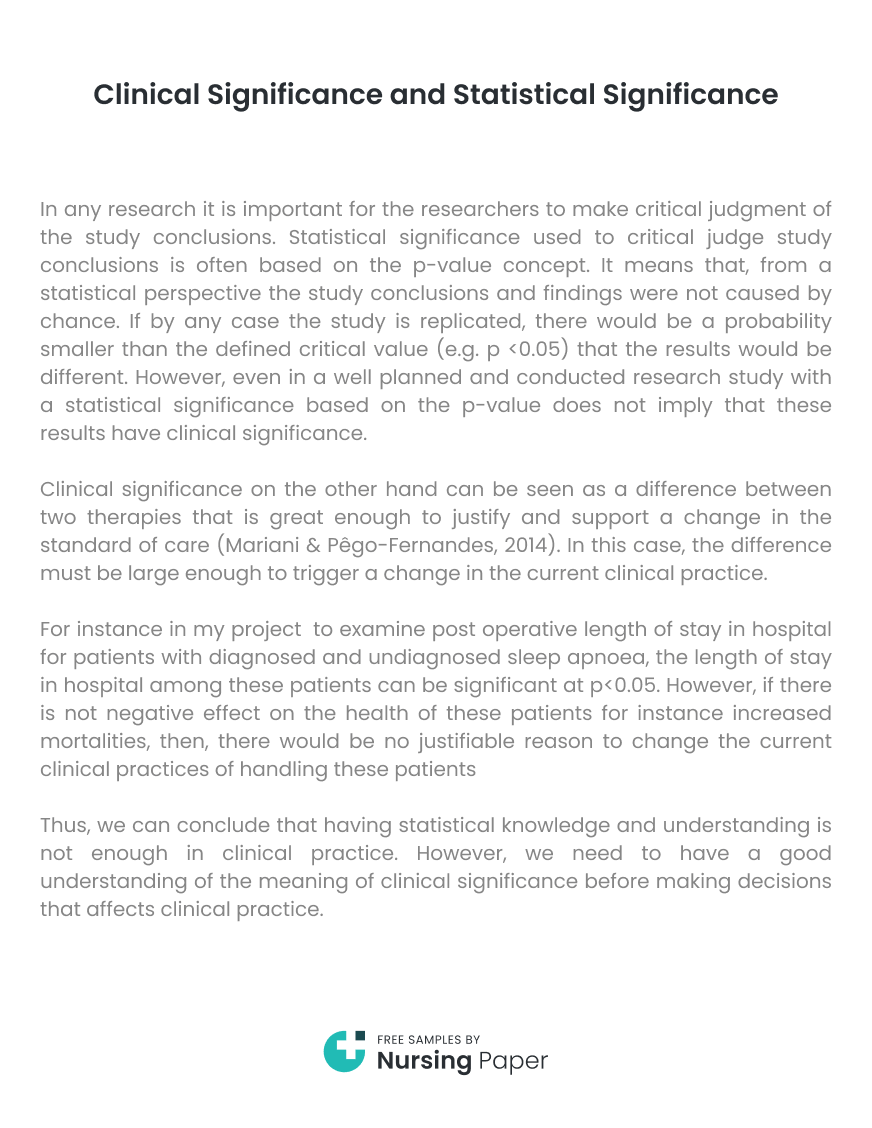
Clinical Significance and Statistical Significance
Introduction
In any research it is important for the researchers to make critical judgment of the study conclusions. Statistical significance used to critical judge study conclusions is often based on the p-value concept. It means that, from a statistical perspective the study conclusions and findings were not caused by chance. If by any case the study is replicated, there would be a probability smaller than the defined critical value (e.g. p <0.05) that the results would be different. However, even in a well planned and conducted research study with a statistical significance based on the p-value does not imply that these results have clinical significance.
Clinical significance on the other hand can be seen as a difference between two therapies that is great enough to justify and support a change in the standard of care (Mariani & Pêgo-Fernandes, 2014). In this case, the difference must be large enough to trigger a change in the current clinical practice.


For instance in my project to examine post operative length of stay in hospital for patients with diagnosed and undiagnosed sleep apnoea, the length of stay in hospital among these patients can be significant at p<0.05. However, if there is not negative effect on the health of these patients for instance increased mortalities, then, there would be no justifiable reason to change the current clinical practices of handling these patients
Conclusion
We can conclude that having statistical knowledge and understanding is not enough in clinical practice. However, we need to have a good understanding of the meaning of clinical significance before making decisions that affects clinical practice.
1. Mariani, A. W., & Pêgo-Fernandes, P. M. (2014). Statistical significance and clinical significance. Sao Paulo Medical Journal, 132(2), 71-72.



The download will start shortly.

The download will start shortly.
 Subject:
Nursing
Subject:
Nursing  Number of pages: 2
Number of pages: 2  Subject:
Medicine
Subject:
Medicine  Number of pages: 2
Number of pages: 2  Subject:
Nursing
Subject:
Nursing  Number of pages: 5
Number of pages: 5  Subject:
Health and Social Care
Subject:
Health and Social Care  Number of pages: 9
Number of pages: 9  Subject:
Nursing
Subject:
Nursing  Number of pages: 4
Number of pages: 4  Subject:
Medicine
Subject:
Medicine  Number of pages: 1
Number of pages: 1  Subject:
Health and Social Care
Subject:
Health and Social Care  Number of pages: 1
Number of pages: 1  Subject:
Health and Social Care
Subject:
Health and Social Care  Number of pages: 7
Number of pages: 7  Subject:
Health and Social Care
Subject:
Health and Social Care  Number of pages: 3
Number of pages: 3  Subject:
Medicine
Subject:
Medicine  Number of pages: 46
Number of pages: 46  Subject:
Health and Social Care
Subject:
Health and Social Care  Number of pages: 2
Number of pages: 2  Subject:
Medicine
Subject:
Medicine  Number of pages: 2
Number of pages: 2  Subject:
Medicine
Subject:
Medicine  Number of pages: 2
Number of pages: 2  Subject:
Medicine
Subject:
Medicine  Number of pages: 2
Number of pages: 2  Subject:
Medicine
Subject:
Medicine  Number of pages: 2
Number of pages: 2 
